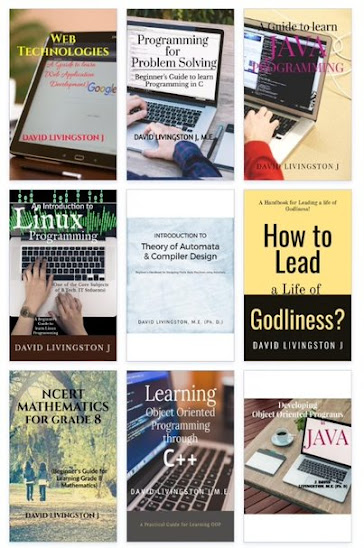FAQ on Basics of Computer Organization
1. Define Computer.
 Computer is a fast electronic calculating machine that accepts
digitized input information, processes it according to a list of
internally stored instructions, and produces the resulting output
information. The list of instructions is called a computer program,
and the internal storage is called computer memory.
Computer is a fast electronic calculating machine that accepts
digitized input information, processes it according to a list of
internally stored instructions, and produces the resulting output
information. The list of instructions is called a computer program,
and the internal storage is called computer memory.
2. Define Hardware
and Software.
Software,
or program enables a computer to perform specific tasks, as opposed
to the physical components of the system (hardware). This includes
application software such as a word processor, which enables a user
to perform a task, and system software such as an operating system,
which enables other software to run properly, by interfacing with
hardware and with other software or custom software made to user
specifications.
Computer
hardware is the physical part of a computer, including the
digital circuitry, as distinguished from the computer software that
executes within the hardware. The hardware of a computer is
infrequently changed, in comparison with software and data, which are
"soft" in the sense that they are readily created, modified
or erased on the computer.
3. What are the
various functions units of a computer? How do they work together to
achieve a task in a computer?
A computer consists of five functionally independent main parts:
input, memory, arithmetic and logic, output and control units. The
input unit accepts coded information from human operators, from
electromechanical devices such as keyboards, or from other computers
over digital communication lines. The information received is either
stored in the computer's memory for later reference or immediately
used by the arithmetic and logic circuitry to perform the desired
operations. The processing steps are determined by a program stored
in the memory. Finally, the results are sent back to the outside
world through the output unit.
4.
Differentiate between Program and Data.
A list of instructions that perform a task is called a program.
Usually the program is stored in the memory. The processor then
fetches the instructions that make up the program from the memory,
one after another, and performs the desired operations.
Data are numbers and encoded characters that are used as operands by
the instructions. The term data, however, is often used to mean any
digital information. Within this definition of data, an entire
program (that is , a list of instructions) may be considered as data
if it is to be processed by another program.
5. List various I/O
devices.
The
following are either standard or very common I/O devices:
Input
devices
- Text input devices
Keyboard
- Pointing devices
Mouse
Trackball
- Gaming devices
Joystick
Game
pad
Game
controller
- Image, Video input devices
Image
scanner
Webcam
- Audio input devices
Microphone
Output
devices
- Image, Video output devices
Printer:
Peripheral device that produces a hard copy. (Inkjet, Laser)
Monitor:
Device that takes signals and displays them. (CRT, LCD)
- Audio output devices
Speakers: A device that converts analog audio signals into the
equivalent air vibrations in order to make audible sound.
Headset: A device similar in functionality to that of a regular
telephone handset but is worn on the head to keep the hands free.
6.List down the basic operations of a computer.
The operation of a computer can be summarized as follows:
- The computer accepts information in the form of programs and data through an input unit and stores it in memory.
- Information stored in the memory is fetched, under program control, into an arithmetic and logic unit, where it is processed.
- Processed information leaves the computer through an output unit.
- All activities inside the machine are directed by the control unit.
7. Identify the various internal hardware devices of a computer.
Motherboard or system board holding the following parts:
- Central processing unit (CPU)
- Computer fan - used to cool down the CPU
- Random Access Memory (RAM) - for program execution and short term data storage, so the computer does not have to take the time to access the hard drive to find the file(s) it requires. More RAM will normally contribute to a faster PC. RAM is almost always removable as it sits in slots in the motherboard, attached with small clips. The RAM slots are normally located next to the CPU socket.
- Basic Input-Output System (BIOS) or Extensible Firmware Interface (EFI) in some newer computers
- Buses
- Power supply - a case that holds a transformer, voltage control, and (usually) a
- Storage controllers of IDE, SATA, SCSI or other type, that control hard disk,
- Floppy disk, CD-ROM and other drives; the controllers sit directly on the
- Video display controller that produces the output for the computer display. This will either be built into the motherboard or attached in its own separate slot (PCI,PCI-E or AGP), requiring a Graphics Card.
- Computer bus controllers (parallel, serial, USB, FireWire) to connect the computer to external peripheral devices such as printers or scanners
- Hard disk - for medium-term storage of data.
- Sound card - translates signals from the system board into analog voltage levels, and has terminals to plug in speakers.
- Networking components like Modem or Network card for for connecting the computer to the Internet and/or other computers
- Expansion slots for connecting any other peripherals
Click here for downloading presentations related to this.



nice post and really intelligent thought.
Good information about computer hardware.
I appreciate your work.........
I am happy to find this post very useful for me, as it contains lot of information.